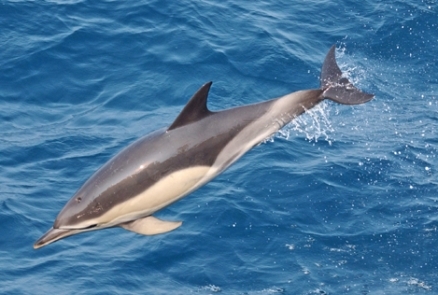Saddle-backed dolphin (Short-beaked common dolphin)
Contents
Saddle-backed dolphin
The Saddle-backeddolphin, (scientific name: Delphinus delphis)one of the the most common dolphin species, is one of three species in the Delphinus genus, and is extremely similar to the Long-beaked common dolphin. In fact, a more common name for this species is the Short-beaked common dolphin.
The Short-beaked common dolphin is extremely energetic and gregarious, and has been known to entertain sailors by bow-riding along their ships. In addition, this species may be found along the coast of nearly every continent in the world. This marine mammal species is a member of the family Delphinus, and part of the order of cetaceans.
 Size comparison of an average human and a common dolphin. Source: Chris Huh Size comparison of an average human and a common dolphin. Source: Chris Huh
| ||||||||||
|
Conservation Status | ||||||||||
|
Scientific Classification Kingdom: Animalia (Animals) | ||||||||||
|
Physical properties
Saddle-backeddolphin are small dolphins under nine feet (2.7metres) long, and weigh about 440 pounds (200kg). They have a rounded melon, moderately long beak, and a sleek but robust body with a tall, pointed, triangular, falcate dorsalfin located in the middle of the back. As adults, males are slightly larger than females.
This cetacean can be identified by its distinct bright colouration and patterns. A dark gray cape extends along the back from the beak and creates a "V" just below the dorsal fin on either side of the body. There is a yellow/tan panel along the flank, between the dark cape and white ventral patch, forward of the dorsal fin. This bold colouration forms a crisscrossing hourglass pattern. A narrow dark stripe extends from the lower jaw to the flipper. There is also a complex colour pattern on the facial area and beak that includes a dark eye patch. The colouration and patterning of young and juvenile dolphins are muted and pale, but become more distinguishable and bolder with maturity. These morphologies can be variable and distinct based on different geographic and regional populations.
Reproduction
Saddle-backeddolphinsare viviparous (live birth), as are all mammals other than the monotremes. Females normally give birth to one calf at a time, but somewhat rarely have been found to carry twins or triplets.
Males become sexually mature between three to twelve years, and females between two to seven years. Breeding usually takes place between the months of June and September, followed by a ten to eleven month gestation period. When the calf is born (tail first) it is three feet long and usually weighs 25 to 35 pounds. Calving can occur annually and lactation lasts approximately four months.
Newborn calves immediately become a part of the family group. The young calf remains close to its mother and never wanders more than a few metres away. The calf suckles milk from the teats of its mother. Unlike human babies, however, dolphins do not have the lips needed to suck the teats. Also they could not breathe efficiently under water if they were able to suck. To solve these problems, the mother squirts milk into her offspring's mouth by contracting muscles. The young dolphin then ascends to the surface to breathe, and then comes down for further feeding. Dolphin milk hassix times more protein and is much more fattening than human milk.This milkallows the young dolphin to increase its weighttwotothree times faster than a human baby does during the first six months. Suckling continues for about a year and a half. After six months, the calf occasionally takes solid food.
Lifespan
Saddle-backeddolphinhave an estimated life span of 35 to 40 years.
Behaviour
These fast-swimming dolphins are highly active, often leaping clear of the water (breaching), and slapping their flippers on the water surface (lobtailing). They occur in large groups of between ten and 500 individuals, the size of group depending on both the time of day, year, age, or sex. The approach of these groups can be detected from miles away, and some noises made by this species can be heard from above the surface of the water. They feed on small fish and cephalopods such as squid, and are known to use co-operative methods of hunting. They execute short dives typically of between ten seconds and two minutes, but dives lasting for as long as eight minutes have been recorded.
Dolphins are very social organisms. Saddle-backeddolphin are seldom alone. They travel and feed in groups, and even breathe in unison! An entire small school may appear in the air at one time. Saddle-back schools can contain as many as 1000 to 100,000 individuals. Saddle-backeddolphin are the most abundant and wide spread species of dolphins.
In higher latitudes, when the first storms of autumn move over the waters, females and their young assemble into large companies to face the vigours of winter. They depend on their large numbers to find food and on their speed and caution for protection. Males live apart from these large herds of females, although they remain in the same area, they stay a considerable distance away until the warmer spring season approaches. Further separation of the sexes occurs in nursery schools of pregnant and nursing females.
Saddle-backed dolphins are playful marine mammals. Thesaddle-backeddolphin is no exception. They are both active and boisterous, performing various flips and somersaults. They commonly leap with their whole bodies out of the water. Saddle-backeddolphin play with one another in a somewhat rough fashion, often rushing towards another indidvidual. A favorite activity of the common dolphin, however, is bow-riding; they ride on ship bow-waves and the pressure waves created by whales. They may stay with the vessel, jumping and playing, for a period of up to several hours.
Saddle-backeddolphins are also a very affectionate species. They care for their sick by using their fins to keep the ailing dolphin afloat so it may breathe. Moreover, they make friends with the members of their groups and evince emotions towards them. In captivity, two males who were separated became quite excited when reunited. Also when members of the group are separated or die, dolphins exhibit emotions of sadness and appear to be pining away for their playmates.
Within the groups, adults act as teachers to the young. Younger dolphins are disciplined when proper manners are not performed. In addition, mothers in the groups share responsibilities in taking care of the young. They take turns watching over those that are hyper-active.
Saddle-backeddolphin, as with other cetaceans, are a very vocal species. They communicate with each other using two voices--one being for navigation and location and the other being for social communication. The voice can be described as whistle-like pulse sounds. Variations in loudness, speed, and pitch convey different messages. In captivity, attempts to teach dolphins to speak are made. Saddle-backeddolphin, however, are not easily trained despite their friendliness. In captivity, the saddle-backed dolphin is uncharacteristically shy. Voices can also be used as aids in "sight." Sound is the primary sense, vision often being challenging, espcially in dark and murky waters
Saddle-backeddolphin are a very helpful and social species. There are reports of their assisting in rescuing humans in the marine environment. They also provide entertainment for sailors as they play along the sides of their ships. Furthermore, fisherman often use Common dolphins in locating fish schools.
Distribution
The abundance and distribution of saddle-backeddolphin vary based on interannual changes, oceanographic conditions and seasons. They can occur on the continental shelf or farther offshore. Along the U.S. west coast, the majority of the populations are found off of California, especially during the warm-water months. Off the U.S. east coast, they are more common north of Cape Hatteras, North Carolina. During summer through autumn, large aggregations can be found near Georges Bank, Newfoundland, and the Scotian Shelf. Other distinct populations can be found off of northern Europe, the Black Sea, Newfoundland, the Mediterranean Sea, Africa,Japan, the southwestern Pacific, southern Australia, and New Zealand.
Habitat
Saddle-backeddolphins prefer warm tropical to cool temperate waters (52-88° F or 10-28° C) that are primarily oceanic and offshore, but still along the continental slope in waters 650 to 6500feet (200 to 2000m) deep. In the western North Atlantic, they are often associated with the Gulf Stream Current.The Saddle-back dolphin also prefers waters altered by underwater geologic features where upwelling occurs.
Ecosystem roles
Saddle-backeddolphins commonly associate with schools of tuna and seabird feeding flocks, especially in the eastern tropical Pacific Ocean. They have also been observed in schools with the Clymene dolphin and the Striped dolphin.
Furthermore, the Saddle-backeddolphin can be seen feeding with the Bottlenose dolphin and the Pacific white-sided dolphin.
Feeding habits
Delphinus delphis feed on small fish as well as squid and octopus. Small fish include young herring, pilchard, anchovies, nocturnal hake, sardines, small bonito, as well as sauries. An individual dolphin consumes up to 20 pounds of fish daily. Groups of common dolphins engage in a cotemporaneous feeding, which can occur either during the day or nocturnally. They are sometimes joined by bands of Bottlenose or White-sided dolphins. These feeding forays can last up to an hour. During such a feeding freinzy, each dolphin rushes to the center of the prey school which the group is pursuing and tries to seize as many fish as possible, which prey it swallows whole. Common dolphins have also been known to dive below prey schools, driving prey to the surface. Often they propel the prey completely out of the water and catch it in midair.
Conservation status and threats
 Saddle-back dolphin postage stamp, Solomon Islands. This species is classified as Least Concern on the IUCN Red List.
Saddle-back dolphin postage stamp, Solomon Islands. This species is classified as Least Concern on the IUCN Red List.
Common dolphins have very few enemies; however, killer whales and some sharks are known predators. D. delphis faces numerous threats at the hands of human beings. They are often exploited by man, in the form of Entanglements in fishing nets, hunting, as well as other human disturbances. These, however, can be avoided if the dolphin is lucky. Unfortunately, common dolphins, as well as other aquatic life, cannot avoid the water pollution that is overtaking their habitats from terrestrial discharge of untreated sewage and agricultural runoff (Surface runoff). Numerous laws have been enacted to protect the dolphins and other marine life, but enforcement is far from uniform.
References and further reading
- Encyclopedia of Life. Species curator: C.Michael Hogan. 2011. Delphinus delphis. Linnaeus, 1758 Saddle-backed dolphin
- IUCN
- NOAA. 2010. Short-Beaked Common Dolphin (Delphinus delphis)
This article was partially researched by a student at Texas Tech University participating in the Encyclopedia of Earth's Student Science Communication Project. The project encourages students in undergraduate and graduate programs to write about timely scientific issues under close faculty guidance. All articles have been reviewed by internal EoE editors, and by independent experts on each topic.



